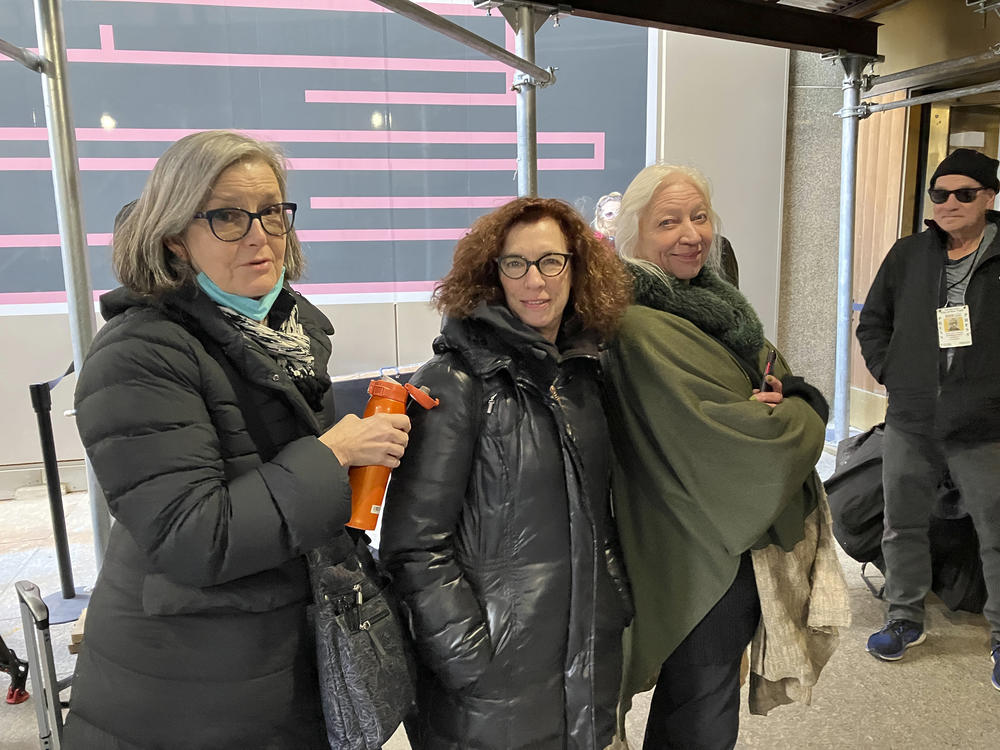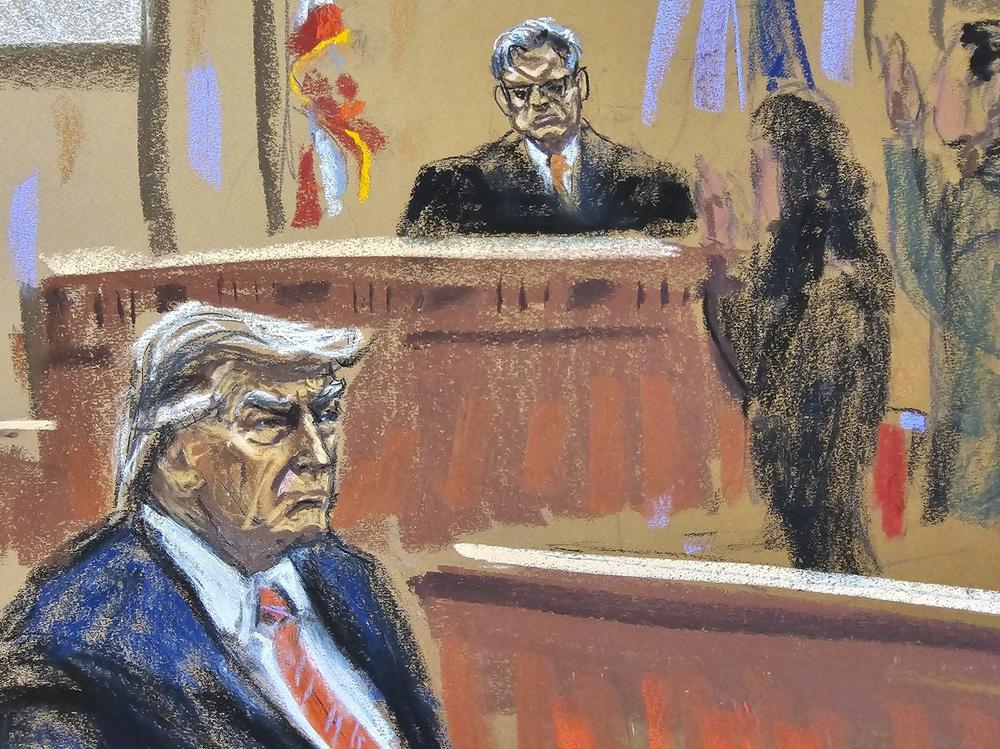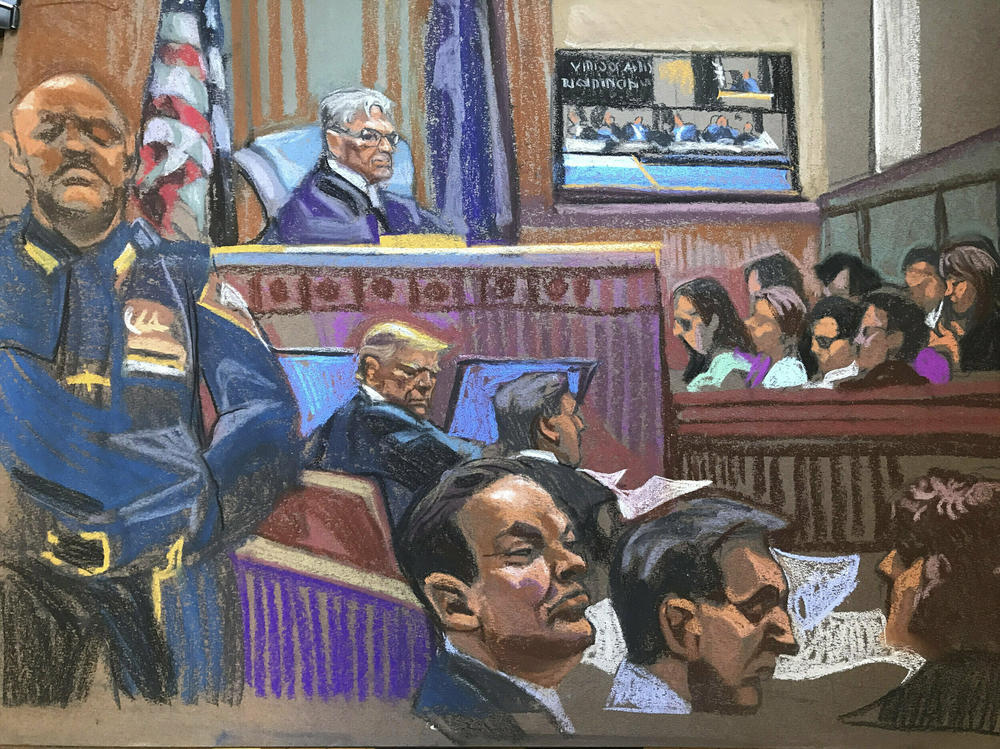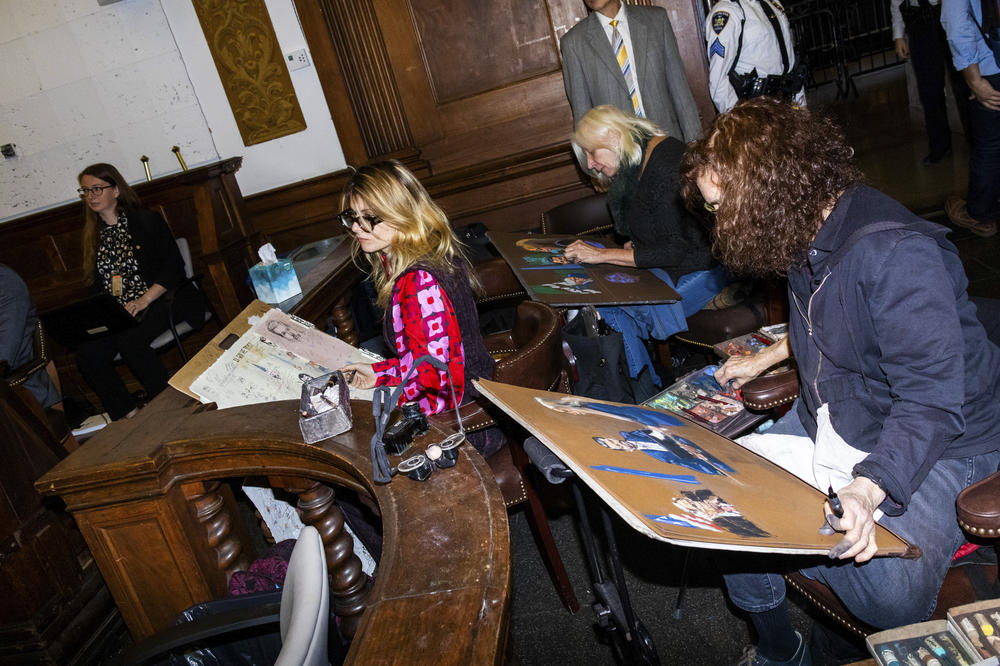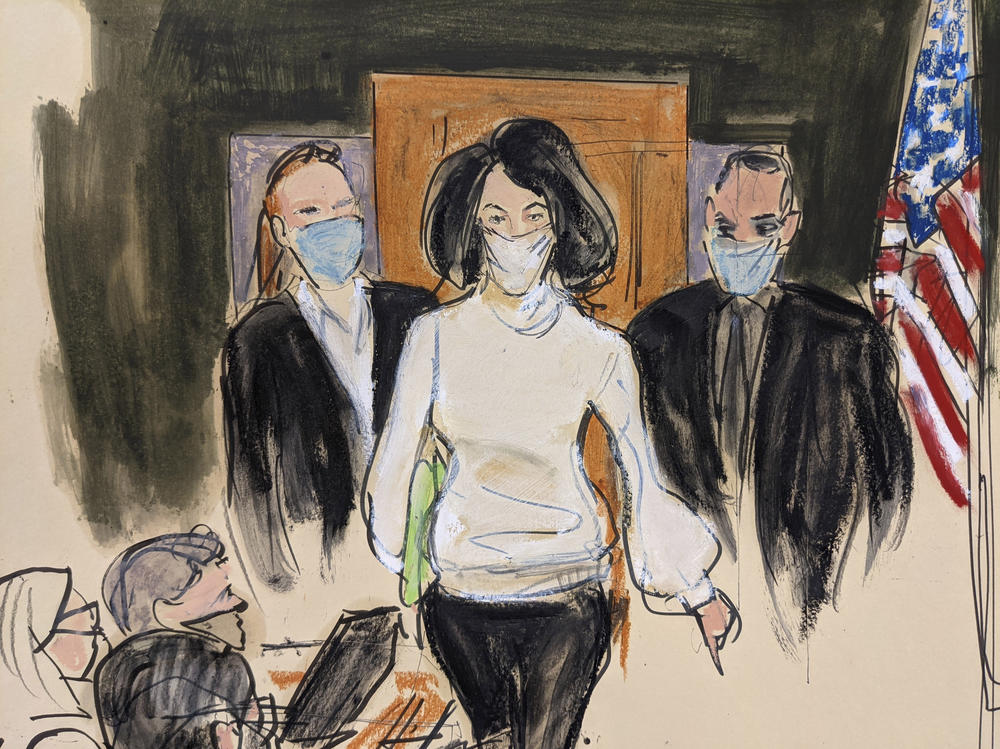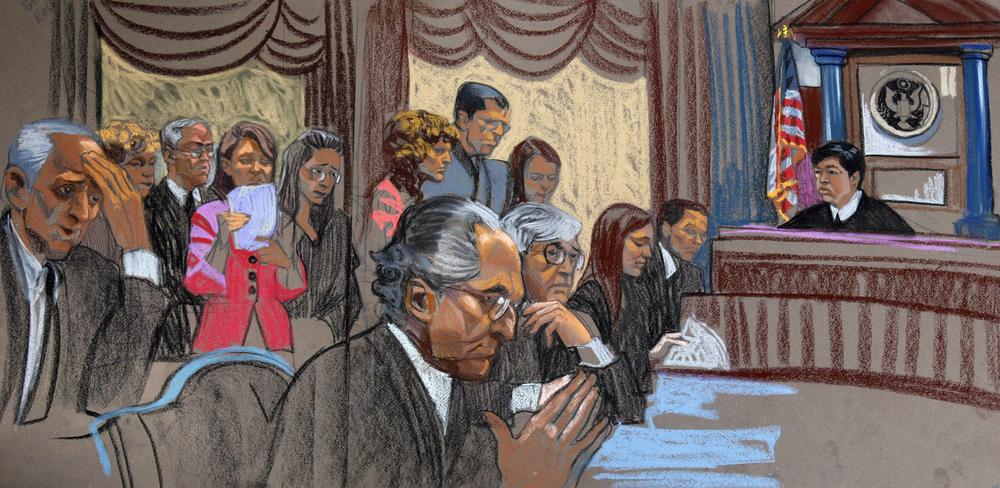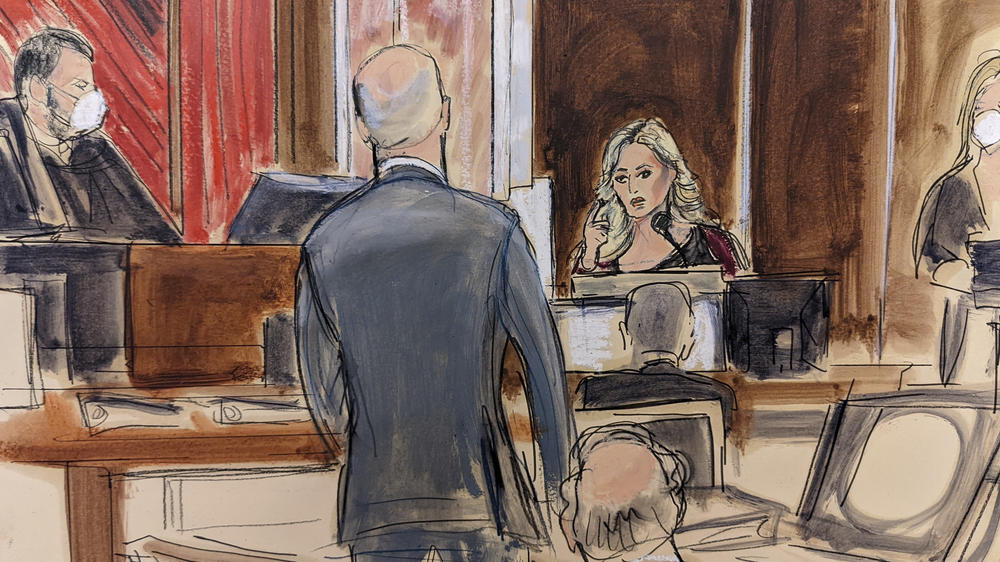Section Branding
Header Content
Here are the courtroom sketch artists drawing Trump's hush money trial
Primary Content
Only the people in the courthouse for former President Donald Trump's hush money trial are able to actually see the proceedings unfold.
The high-profile case is not being livestreamed, and photography has been off limits, save for a few still photos of Trump at the start of the trial.
What the rest of us see, we see by viewing the sketches of several courtroom artists who are seated in the gallery, glancing at a turned head or fleeting facial expression, and transforming those impressions into art that's then shared widely in the news and across social media.
"It's not always about drawing the most perfect, beautiful picture," said Elizabeth Williams, who is sketching the trial for the Associated Press. "It's about trying to draw the most honest and true and real moment, so people can understand what's going on in that courtroom."
Williams — along with fellow sketch artists Christine Cornell and Jane Rosenberg — have been hired by various news outlets to draw scenes from Trump's historic criminal trial in Manhattan, which is ongoing.
Prosecutors say Trump committed election fraud ahead of the 2016 presidential contest by arranging hush money payments that would prevent several stories about him from coming out. Trump has pleaded not guilty.
The trio are among a dwindling group of courtroom sketch artists whose numbers are in decline as more jurisdictions have begun allowing journalists to photograph and film legal proceedings.
Courtroom art has been around for centuries and given the public a view into some of the most notable legal moments in history. But after the frenzy inside the 1935 trial of Richard Hauptman, who was found guilty of murdering the child of aviator Charles Lindbergh, the American Bar Association said cameras should be prohibited in courts, according to the Library of Congress.
That changed in the 1970s as more states began allowing photography and filming in court, and a recent report from the Fund for Modern Courts found that just New York, Louisiana and Washington, D.C., restrict video coverage at most or all trial court proceedings.
Cornell said there are far fewer courtroom sketch artists now than there were when she started in 1975, and that doesn't appear to be changing. "There's no one really coming up in the ranks, you know, no one really coming out to do this work," she said.
But some court systems still bar cameras, which allows the artists to practice what they all say they love about courtroom sketching: drawing people.
"I went to college when abstract art was big, and I was very discouraged," said Rosenberg, who became a courtroom artist in 1980. "During college they always said, 'Oh that's passé, it's been done, find something new to do.' But I always loved drawing people."
Cornell began sketching court scenes after following her sister, a CBS radio reporter, to a trial she was covering. She said she's always been passionate about sketching people and hearing interesting stories. "The defendant becomes my muse, and I draw them again and again and again," she said.
It's not simply drawing people, though. The artists aim to capture the mood in the room in what Cornell described as a kind of "time-lapse" process. "You're grabbing elements and putting them together and essentially just trying to capture the gestalt and tell the story."
Courtroom artists say their job is a stressful one, overflowing with constant logistical obstacles, such as visual barriers and newsroom deadlines.
"I had a knot in my stomach for probably at least the first 10 years if not now still. It's really hard, a lot of stress," said Rosenberg, who's been sketching Trump's criminal trial for Reuters and other news outlets. "But it gets my adrenaline flowing, so I love it."
The high-security trial of the former president is no different. Sitting several rows back, the artists often only see the backs of Trump's and the attorneys' heads. Security personnel are stationed throughout the courtroom, and sometimes the artists don't have a clear view of witnesses. All three said they've used binoculars to see the courtroom's internal video feed.
Cornell, who is covering the case for CNN, even brought several seat cushions to prop herself up for a higher vantage point. "It's not a glamorous job," she quipped.
When Trump does turn around, it may only be very briefly, as in one day when his son Eric came to court to speak with his father. "[Trump] stood at the rail and they exchanged a few words, and I was able to see his face straight on," Cornell said. "I felt very fortunate."
Facing tight deadlines, the artists sometimes must file multiple drawings per day.
"You have to make do," Williams said, adding that the constraints of the job can also produce interesting results. "If you don't think things through so much, you can actually get some really nice — as I call them — cinéma vérité moments."
For Rosenberg, Trump has been enjoyable to draw. He wears "brilliant blue" suits with shirts that are "whiter than white" and "scarlet red" ties, she said.
"He has an expression, most of the time, that sort of looks like a pouty small child who's on the verge of throwing a tantrum because he didn't get his way," Rosenberg added. "Occasionally he smiles. He comes in the morning, and it seems like he has his eyes closed most of the morning."
Trump has seen at least some of the sketches of himself. He reportedly told the artist Isabelle Brourman in December, after viewing one of her drawings of him, that he's "gotta lose some weight."
Members of the public are also quick to lob criticism at courtroom sketch artists, Williams said. People are used to seeing the features of celebrities in great detail in photographs and videos, and she said some particularly strident critics have even dedicated entire blogs to the worst celebrity court sketches.
"That tends to be something that will really get under people's skin, is if a drawing is not exactly the way a celebrity looks, whether it's Donald Trump or Taylor Swift or Lindsay Lohan or Kim Kardashian," she said.
"Well, guess what? It's not always that easy to draw a celebrity exactly the way they look," Williams added. "You're not able to use a photograph. ... You don't have that kind of time. And you're drawing what's in front of you, and you draw to the best of your ability."
All three artists said their goal is to give viewers a sense of what it was like to be present during these momentous situations, since it is the only way for the vast majority of Americans to have any idea about what people looked like in those moments.
Cornell said she views her work as a public service. "I'm bringing my full heart in there to do as true a picture as I can, to really have people feel what it's like to be in that room," she said.
"Not just an arrangement of folks," Cornell added. "It's got to have a little bit of the human drama."
Bottom Content

